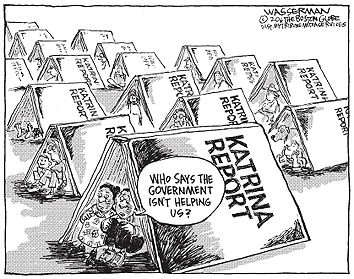Six Months After Katrina


The following is eyewitness testimony of the first five days of Katrina. Bill Quigley and his wife, Debbie, an oncology nurse, volunteered their help at a New Orleans hospital so other nurses with children could check on their families. We will be presenting this extraordinary story, in a condensed/edited version, as a series in each month’s newsletter. The story in its entirety can be found at www.CommonDreams.org.
There were about 2000 people huddled in the hospital—patients, staff, and families. Plate glass windows exploded in the lobby and on crosswalks and on several floors. Water poured in through broken windows, ceilings, and down the elevator shafts. Eight feet of brown floodwater surrounded us. Soon the hospital backup generators located in the basement failed. No lights. No phones. No drinking water. No flush toilets. Breathing machines did not work. We quickly ran out of food because the cafeteria and food were also in the flooded basement. Over 40 people died in the hospital over the next few days as we waited for help.
Who was left behind?
We certainly knew the 2000 of us were left behind, and from the hospital we could see others. Some were floating in the street, face down. Some were paddling down the street, helping older folks get to high ground. Some were swimming down the streets. We could hear people left behind screaming for help from rooftops. We routinely heard gunshots as people trapped on rooftops tried to get the attention of helicopters crisscrossing the skies above. We could see the people trapped in the Salvation Army home a block away. We could hear breaking glass as people scrambled to get away from flooded one-story homes and into the higher ground of several-story office buildings. We saw people swimming to the local drugstore and swimming out with provisions. The poor, especially those without cars, were left behind. Twenty-seven percent of the people of New Orleans did not have access to a car. Government authorities knew in advance that “100,000 citizens of New Orleans did not have means of personal transportation.” These are people who did not have cars because they were poor—over 125,000 people, 27% of the people of New Orleans, lived below the very low federal poverty level before Katrina.
The sick were left behind. Some government reports estimated 12,000 patients were evacuated. I estimate at least an additional 24,000 people—staff and families of patients—were left behind in the 22 hospitals that were open at the time.
The elderly were left behind. The 280 plus local nursing homes remained mostly full. Only 21%evacuated and, as a consequence, 215 people died in nursing homes, at least six of them at a single nursing home where they waited four days for buses. The aged who lived at home also certainly found it more difficult than most to evacuate as they were more likely to live alone, less likely to own a car and nearly half were disabled.
Children were left behind. About one-fourth of the people living in the areas damaged were children—183,000 kids, including 47,000 children under the age of five. Over half of the children displaced were African-American, and 30% of children in the damaged areas were poor, nearly double the 2000 national census rate of 16.6% for child poverty. These children were almost twice as likely to live in a female-headed home than children nationally.
Prisoners were left behind. Thousands were left behind with no food, water, or medical attention— 8300 inmates, most on local minor charges awaiting trial and too poor to post bond. More than 600 prisoners were left chest deep in water, locked into cells. (Continued next month.)